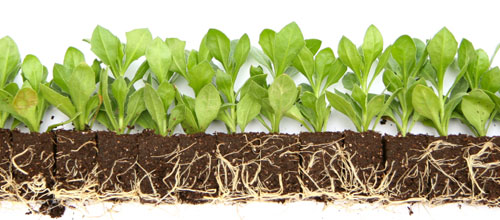GMS Products. Grace's Rooting Compound

Grace’s Rooting Compound is an environmentally-safe, inexpensive, and effective rooting stimulant for plant propagation that is safe to use in phyto-remediation projects, as well as on ornamental trees and fruit trees that have yet to bear fruit. Registered with the EPA, it has a non-toxic mode of action because:
- It is applied in low volumes.
- It is target-specific and is only used on the tip of the cutting.
- It duplicates a naturally-occurring process in plants.
Benefits
Grace’s Rooting Compound is available in a concentrated liquid dip form that offers several benefits for clean-up projects utilizing phytotechnology, as well as residential and commercial growers:
- It promotes a symmetrical growth pattern of roots that bolsters the propagation process.
- It enhances the propagation of trees used for phyto-remediation when applied to the root ball prior to planting.
- It allows the propagator to easily select the exact concentration for each crop.
- It provides more uniform coverage.
- It provides a more rapid absorption.
- It is self-sanitizing, which eliminates cross contamination.
The Way it Works
There are three types of cuttings for plants – softwood or succulent, medium-hardwood, and hardwood.
Softwood or Succulent: Softwood is the emerging growth of most plants. It can be easily bruised with a nail. Softwood cuttings should be kept cool and moist. Very soft softwood cuttings may rot. The general dilution rate for Grace’s Rooting Compound is 1:20 for this type of cutting.
Medium-Hardwood: Broadleaf evergreens when the wood is firm and leaves have matured. The general dilution rate for Grace’s Rooting Compound is 1:10 for this type of cutting.
Hardwood: Deciduous plants after they have lost their leaves in the fall, needle evergreens, and broadleaf evergreens. Cuttings from needle evergreens are usually rooted under greenhouse conditions. The general dilution rate forGrace’s Rooting Compound is 1:5 for this type of cutting.
To determine the best concentration for any variety, try three dilutions of 1:5, 1:10, and 1:15. Liquid dips tend to form roots to the depth of the dipping, so control the depth to the desired area of rooting. Dip the cutting long enough to thoroughly wet the base of the cutting.
Results
Application of the product should result in an abundance of root growth which is essential for phyto technology, the process of cleaning contaminated sites utilizing plant life.
Growth periods for plantings should accelerate with the application of the product (example: grapevine cuttings have experienced a shortened maturation period from four years to two years due to the application of the rooting compound).
Notes on Grace’s Rooting Compound Process
- Flash Point – Non-Flammable
- Environmentally safe!
- pH=0.9 at the concentrated form.
Cuttings should be taken from thriving and health plants, optimally from the plant’s new growth. Perform the following:
- Locate an active growing tip, with three nodes, or leaf joints, around three sets of developed leaves and a cutting approximately three to six inches in length.
- Find a growing tip. Move down the plant to find the first, second, third, and then fourth node.
- Remove all flower sites and trim off the leaves on the third and fourth nodes, leaving at least two sets of leaves. For cloning softwoods, it is especially important to trim the leaves of the cutting while it is still attached to the plant. NOTE: Use a sharp knife to prevent the least amount of damage.
- After trimming the leaves, separate the cutting from the donor plant midway between the fourth and fifth node. This allows room for the donor plant to heal itself.
- Dip at least one set of nodes of the cutting in the prepared Grace’s Rooting Compound solution as soon as possible. Gently shake off excess solution.
- Place cutting in a moistened medium, making sure to cover any areas touched by the rooting compound.
PhytoTechnology
Phytotechnology offers the potential to treat a wide range of contaminants effectively at a lower cost than traditional technologies.
Various plants are utilized to degrade, extract, contain, or immobilize contaminants such as chlorinated solvents, metals, explosives and propellants, pesticides, polycyclic aromatic hydrocarbons, radionuclides, and petroleum hydrocarbon compounds, according to the U.S. Environmental Protection Agency. Phytotechnology has been an accepted method of treating contaminated soil and groundwater by federal, state, and private sector organizations since the 1980’s.
GreenMarket Solutions is proud to distribute an effective and safe aid in the development of phyto-technology projects in Grace’s Rooting Compound.